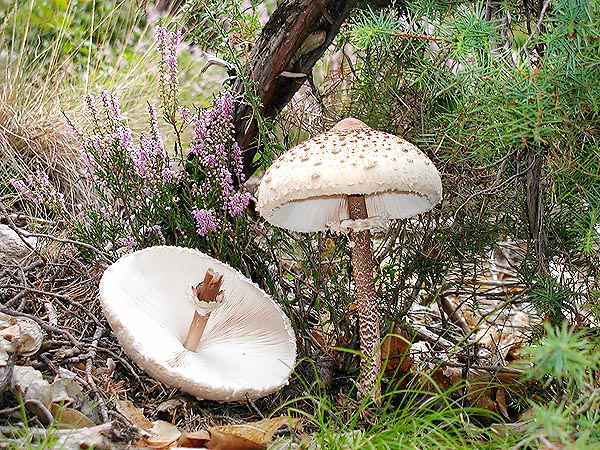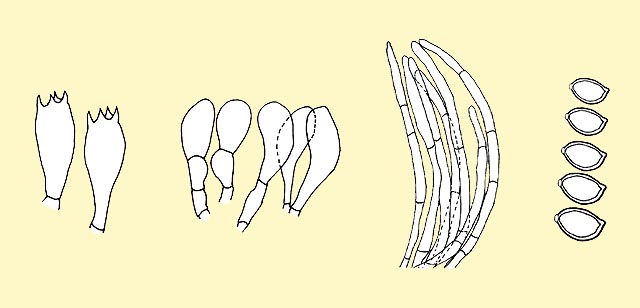
Text © Pierluigi Angeli

English translation by Mario Beltramini

Called “Drumstick” for the look of the closed fungus, choice edible © Giuseppe Mazza
Family: Agaricaceae Chevallier (1826).
Genus: Macrolepiota Singer (1948).
Section: Macrolepiota Bon (1981).
Subsection: Macrolepiota Bon (1981).
Macrolepiota procera (Scopoli : Fries) Singer (1948).
The name comes from the Latin word “procerus”, which means tall, grown taller, slender; currently known in Italy as “Mazza da tamburo” = drumstick, due to its shape when the cap is still closed, similar to the sticks used for beating the drums.
Description of the genus
The genus Macrolepiota is characterized by tricholomoid, collibioid, carpophores, with central stem, long, bulbous at the base; the insertion of the gills, free at the stem, often with a collarium. The carpophores are rather robust, even if variable in their dimensions, but the ratio diameter of cap / height is always more or less constant. The cap has a scaly, flaky, floccose surface, with smooth disk zone and never striate margin.
The stem and cap are not viscous, but always dry; the stem can be decorated or not, and has movable double or simple ring. The spore-print is white or pale pink.
Description of the species
Cap: diameter from 10 to 30 (40) cm, very fleshy, initially egg-shaped, later campanulate and finally, umbrella-shaped, with a wide blunt, whitish, beige umbo, with darker centre, fibrous-downy margin and cuticle which breaks up in large brown-chestnut scales which easily fall and give a glimpse of the underlying white.
Gills: free on the stem, with collarium, thick, wide, easily detachable from the flesh of the cap, intercalated with lamellulae, regular entire edge, white, cream-white.
Stem: 10-40 x 1,5-4 cm, slender, cylindrical, attenuated on top, with bulbous base, fistulous, pale-brownish, covered by fibrillose, deep brown, scales placed in a concentric way. High ring, wide, double, freely movable on the stem, white on the upper side, brown, on the lower one, split margin.
Flesh: firm, thick at the centre, non-staining white, somewhat spongy, with a light fungine smell, sweet taste.

Macrolepiota procera basidia, cheilocystidia, pileipellis and spores © Pierluigi Angeli
Habitat: ubiquitous species; it grows in the meadows, in woods, both of broad leaved trees and of coniferous ones, and in the clearings, from the lowlands to the mountain, in summer and autumn. Rather common species.
Edibility: excellent edible, usually, the cap is utilized, but also the ring is very good, raw, in salad. The powder obtained from the desiccated stem is much utilized too.
Spores: smooth, dextrinoid, metachro- matic, with thick skin, with prominent germinative pore, 12,75-20,00 x 8,10-11,25 µm.
Basidia: club-shaped, with up to 5-5,5 µm, tetrasporic, but also two-spored.
Cheilocystidia: irregularly clavate, at times ventricose, some of them septate.
Remarks: unmistakable species due to its appearance, it is, by sure, the most known Macrolepiota. It is easily identified thanks to its remarkable size; the cap can have a diameter of even 40 cm and the stem is very slender, well longer than the diameter of the cap itself, and decorated by a typical snakeskin pattern.
It may be mistaken with Macrolepiota olivascens which, anyway, has a pale-pink spore-print and gills which stain of greenish when ripe or when touched, as well as with Macrolepiota fuliginosa which, on the contrary, has rather frail scales on the sooty brown cap and almost blackish decorations on the stem towards the base. Even if belonging to another Section, the Macrolepiota rachodes might mislead, but it is smaller, has a smooth stem, without decorations, and, when ripe or touched, it becomes reddish brown, like its white flesh turns to bright carrot-red, especially on the stem, when bruised.
Basionym: Agaricus procerus Scopoli (1772).
Synonyms: Agaricus annulatus Lightfoot (1777); Agaricus colubrinus Bulliard (1782); Agaricus antiquatus Batsch (1783); Agaricus procerus Scopoli : Fries, (1821); Lepiota procera (Scopoli : Fries) Gray, (1821); Amanita procera (Scopoli) Fries (1836); Mastocephalus procerus (Scopoli : Fries) Patouillard, (1900); Lepiotophyllum procerum (Scopoli) Locquin (1942).
→ For general notions about Fungi please click here.
→ To appreciate the biodiversity of MUSHROOMS please click here.
